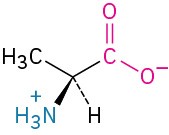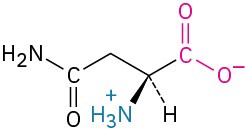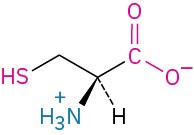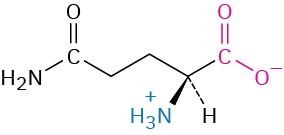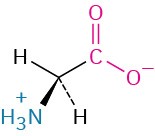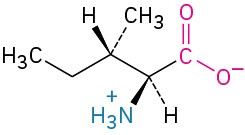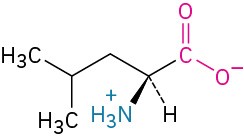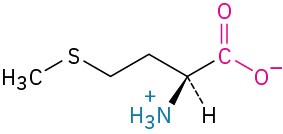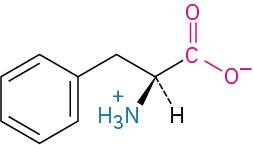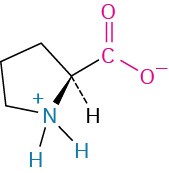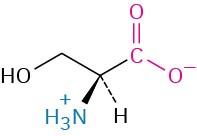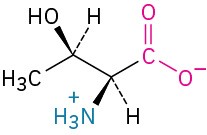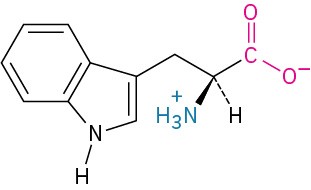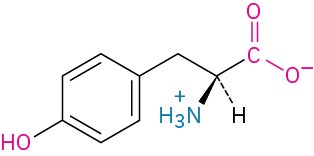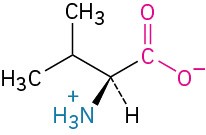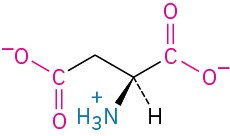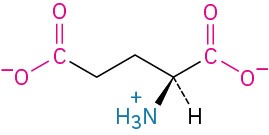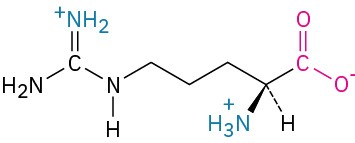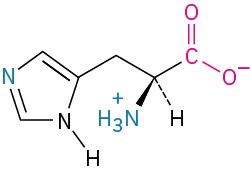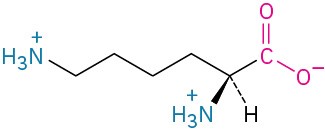26.1 Structures of Amino Acids
We saw in Section 20.3 and Section 24.5 that a carboxyl group is deprotonated and exists as the carboxylate anion at a physiological pH of 7.3, while an amino group is protonated and exists as the ammonium cation. Thus, amino acids exist in aqueous solution primarily in the form of a dipolar ion, or zwitterion (from the German zwitter, meaning “hybrid”).

Amino acid zwitterions are internal salts and therefore have many of the physical properties associated with salts. They have large dipole moments, are relatively soluble in water but insoluble in hydrocarbons, and are crystalline with relatively high melting points. In addition, amino acids are amphiprotic; they can react either as acids or as bases, depending on the circumstances. In aqueous acid solution, an amino acid zwitterion is a base that accepts a proton onto its –CO2– group to yield a cation. In aqueous base solution, the zwitterion is an acid that loses a proton from its –NH3+ group to form an anion.

The structures, abbreviations (both three- and one-letter), and pKa values of the 20 amino acids commonly found in proteins are shown in Table 26.1. All are α-amino acids, meaning that the amino group in each is a substituent on the α carbon—the one next to the carbonyl group. Nineteen of the twenty amino acids are primary amines, RNH2, and differ only in the nature of their side chain—the substituent attached to the α carbon. Proline is a secondary amine whose nitrogen and α carbon atoms are part of a five-membered pyrrolidine ring.
Table 26.1 The 20 Common Amino Acids in Proteins
|
Name |
Abbreviation s |
M W |
Structure |
pKa α– CO2 H |
pKa α– NH3+ |
pKa side chai n |
pI |
|
|
Neutral Amino Acids |
||||||||
|
Alanine |
Ala |
A |
8 9 |
|
2.34 |
9.6 9 |
— |
6.0 1 |
|
Asparagine |
Asn |
N |
13 2 |
|
2.02 |
8.8 0 |
— |
5.4 1 |
|
Cysteine |
Cys |
C |
12 1 |
|
1.96 |
10.2 8 |
8.18 |
5.0 7 |
|
Glutamine |
Gln |
Q |
14 6 |
|
2.17 |
9.1 3 |
— |
5.6 5 |
|
Glycine |
Gly |
G |
7 5 |
|
2.34 |
9.6 0 |
— |
5.9 7 |
|
Isoleucine |
Ile |
I |
13 1 |
|
2.36 |
9.6 0 |
— |
6.0 2 |
|
Leucine |
Leu |
L |
13 1 |
|
2.36 |
9.6 0 |
— |
5.9 8 |
|
Methionine |
Met |
M |
14 9 |
|
2.28 |
9.2 1 |
— |
5.7 4 |
|
Phenylalanin e |
Phe |
F |
16 5 |
|
1.83 |
9.1 3 |
— |
5.4 8 |
|
Proline |
Pro |
P |
11 5 |
|
1.99 |
10.6 0 |
— |
6.3 0 |
|
Name |
Abbreviation s |
M W |
Structure |
pKa α– CO2 H |
pKa α– NH3+ |
pKa side chai n |
pI |
|
|
Serine |
Ser |
S |
10 5 |
|
2.21 |
9.1 5 |
— |
5.6 8 |
|
Threonine |
Thr |
T |
11 9 |
|
2.09 |
9.1 0 |
— |
5.6 0 |
|
Tryptophan |
Trp |
W |
20 4 |
|
2.83 |
9.3 9 |
— |
5.8 9 |
|
Tyrosine |
Tyr |
Y |
18 1 |
|
2.20 |
9.1 1 |
10.0 7 |
5.6 6 |
|
Valine |
Val |
V |
11 7 |
|
2.32 |
9.6 2 |
— |
5.9 6 |
|
Acidic Amino Acids |
||||||||
|
Aspartic acid |
Asp |
D |
13 3 |
|
1.88 |
9.6 0 |
3.6 5 |
2.7 7 |
|
Glutamic acid |
Glu |
E |
14 7 |
|
2.19 |
9.6 7 |
4.2 5 |
3.2 2 |
|
Basic Amino Acids |
||||||||
|
Arginine |
Arg |
R |
17 4 |
|
2.17 |
9.0 4 |
12.4 8 |
10.7 6 |
|
Histidine |
His |
H |
15 5 |
|
1.82 |
9.1 7 |
6.0 0 |
7.5 9 |
|
Abbreviation s |
M W |
Structure |
pKa α– CO2 H |
pKa α– NH3+ |
pKa side chai n |
pI |
||
|
Lysine |
Lys |
K |
14 6 |
|
2.18 |
8.9 5 |
10.5 3 |
9.7 4 |
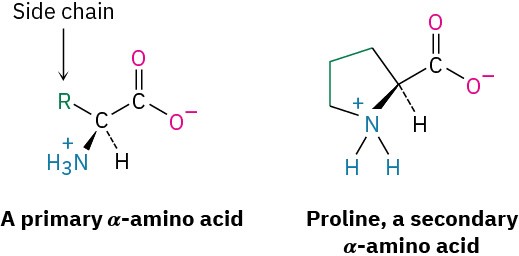
In addition to the 20 amino acids commonly found in proteins, 2 others—selenocysteine and pyrrolysine—are found in some organisms, and more than 700 nonprotein amino acids are also found in nature. γ-Aminobutyric acid (GABA), for instance, is found in the brain and acts as a neurotransmitter; homocysteine is found in blood and is linked to coronary heart disease; and thyroxine is found in the thyroid gland, where it acts as a hormone.
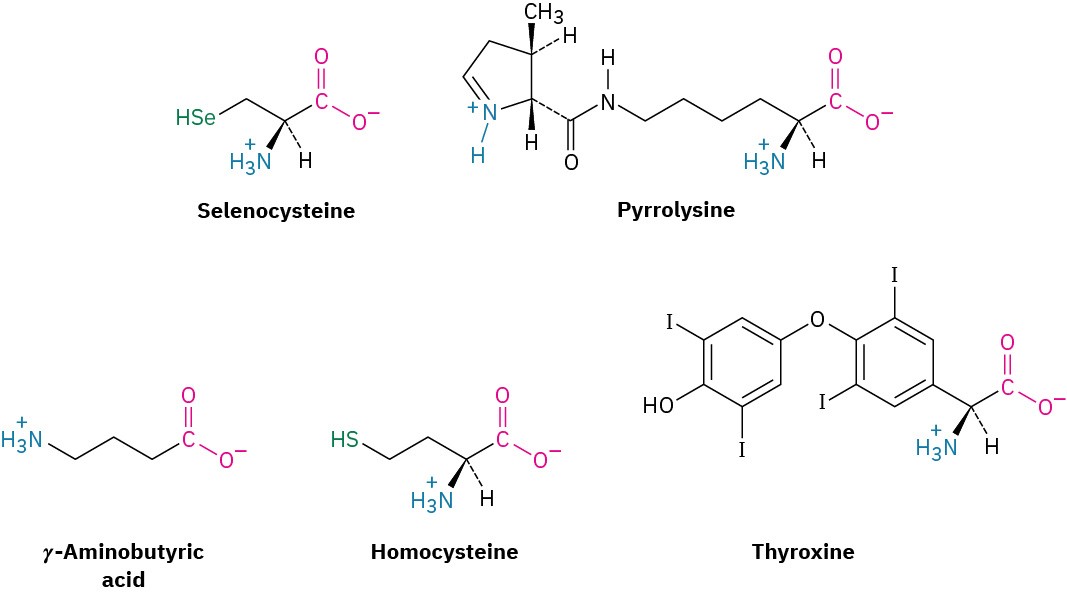
Except for glycine, H2NCH2CO2H, the α carbons of amino acids are chirality centers. Two enantiomers of each are therefore possible, but nature uses only one to build proteins. In Fischer projections, naturally occurring amino acids are represented by placing the –CO2– group at the top and pointing the side chain downwards, as if drawing a carbohydrate (Section 25.2) and then placing the –NH3+ group on the left. Because of their stereochemical similarity to L sugars (Section 25.3), the naturally occurring α-amino acids are often
referred to as L amino acids. The nonnaturally occurring enantiomers are called D amino acids.

The 20 common amino acids can be further classified as neutral, acidic, or basic, depending on the structure of their side chains. Fifteen of the twenty have neutral side chains, two (aspartic acid and glutamic acid) have an extra carboxylic acid function in their side chains, and three (lysine, arginine, and histidine) have basic amino groups in their side chains.
Note that both cysteine (a thiol) and tyrosine (a phenol), although usually classified as neutral amino acids, nevertheless have weakly acidic side chains that can be deprotonated in a sufficiently basic solution.
At the physiological pH of 7.3, the side-chain carboxyl groups of aspartic acid and glutamic acid are deprotonated and the basic side-chain nitrogens of lysine and arginine are protonated. Histidine, however, which contains a heterocyclic imidazole ring in its side chain, is not quite basic enough to be protonated at pH 7.3. Note that only the pyridine-like, doubly bonded nitrogen in histidine is basic. The pyrrole-like singly bonded nitrogen is nonbasic because its lone pair of electrons is part of the six-π-electron aromatic imidazole ring (Section 24.9).
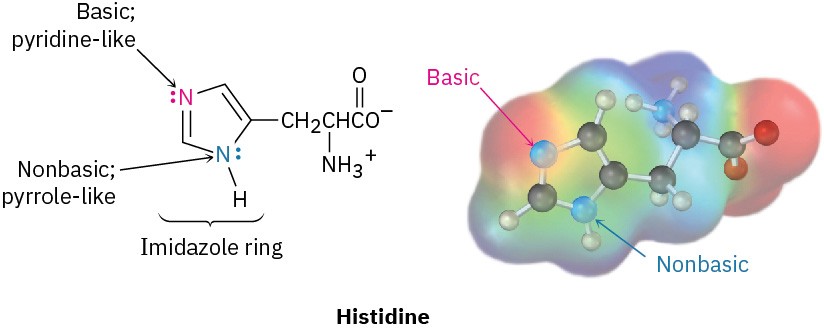
Humans are able to biosynthesize only 11 of the 20 protein amino acids, called nonessential amino acids. The other 9, called essential amino acids, are biosynthesized only in plants and microorganisms and must be obtained in our diet. The division between essential and nonessential amino acids is not clear-cut, however. Tyrosine, for instance, is sometimes considered nonessential because humans can produce it from phenylalanine, but phenylalanine itself is essential and must be obtained in the diet. Arginine can be synthesized by humans, but much of the arginine we need also comes from our diet.
Problem 26-1
How many of the α-amino acids shown in Table 26.1 contain aromatic rings? How many contain sulfur? How many contain alcohol groups? How many contain hydrocarbon side chains?
Problem 26-2
Of the 19 L amino acids, 18 have the S configuration at the α carbon. Cysteine is the only L amino acid that has an R configuration. Explain.
Problem 26-3
The amino acid threonine, (2S,3R)-2-amino-3-hydroxybutanoic acid, has two chirality centers.
- Draw threonine, using normal, wedged, and dashed lines to show dimensionality.
- Draw a diastereomer of threonine, and label its chirality centers as R or S.

